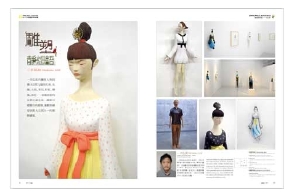Interview for Taiwan dpi Magazine

Q1: How do you describe your creating style?
A1: My style is based on techniques learned from the classical style of ancient Buddhist statues in Japan. I use the tree of life to represent our people.
Q2: What kind of materials, tools and techniques do you like using for your creation?
A2: I use wood carvings. I also make extensive use of various materials and techniques, such as crystal, metal, and Japanese lacquer. The tools I use are tools that are meant to last, such as engravings.
Q3: We find that most of the sculptures are sitting on the chair, is there any specific meaning? And why do that?
A3:I think I can express the inner human essence better in a sitting statue more so than in a standing statue. On the other hand, a standing statue has a stronger physical element or presence than a sitting statue.
Q4: When these sculptures are exhibited in the gallery, how do want to express the whole space? How do you want to make people feel?
A4: I try to represent sacred spaces, such as churches and shrines. I want to feel the human side of people. I want to make people feel as if their hearts have opened and spread to take the art in.
Q5: How long do you complete a piece of work? What’s the most difficult step when you are creating?
A5:How long it takes to complete a work depends on the work. Usually between about half a month to three months. The most difficult step is to conceive of how a sculpture will come to life.
Q6: When we see the sculpture, it makes us feel peace. What’s the important messages do you want to communicate with people by these sculptures?
A6:Harmony between humans, and harmony between humans and nature. I am also very interested in communication the idea of reincarnation.
Q7: Would you select your favorite sculpture and share the reason with us? (image needed)
A7: My favorite is the Buddhist image maker from 1000 years ago because they give me a strong sense of history and reincarnation. /My favorite is “Seated sun figure” because it has most power for protect people. (I am not clear -- is the question about my favorite sculpture in general, or a favorite sculrpture from the ones he made?)
Q8: Your artworks are popular in Art Taipei 2011, and how do you think about that? Moreover, what’s your next plan and is there any on-going project now?
A8: I am very happy to see that people from around the world understand and appreciate different cultures and customs, and I am also surprised. Now I think that even though our languages are different, our hearts and mind speak the same language.